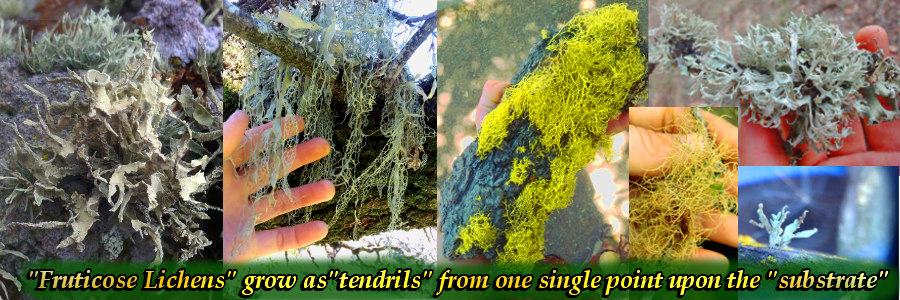Identify a Lichen:
Lichens are a type of composite organism created when algae and/or cyanobacteria form a symbiotic relationship with fungi.
Although some features of lichen are plant-like, they’re unique from fungi and plants. The algae and/or cyanobacteria portion of lichens produce food from photosynthesis; the fungus portion of the lichen provides an anchor for the organism, and gathers minerals & water from the surrounding environment. Lichens grow in a wide variety of environmental conditions and are generally organized by the growth structure they display. Lichen Glossary.
Which of the 5 “structure types” is the lichen?
1. Foliose – “foliage-like”. Contains “leafy” perimeter:
Click to Enlarge:
2.) Fruticose – arises from the substrate (surface that it is growing on). Grows in “tendrils”:
Click to Enlarge:
These types below aren’t generally harvested due to their delicate structure types:
Photos coming soon:
Crustose – “crust-like”. Grows like a “crust” tightly against the substrate (usually rock or wood).
Squamulose – contains tiny “scales”.
Leprose – consisting only of a powdery substance. No distinct parts.
Other Types of Lichen growth structures include:
Gelatinous – thallus structure is jelly-like
Filamentous – thallus is stringy or like matted hair
Byssoid -thallus has a wispy structure (somewhat like teased wool)
Structureless – having no consistent growth structure or characteristics
Harvesting Lichens:
Lichen can be very sensitive to air pollution, & are surprisingly precise air quality monitors! Because of this, they often grow sparsely in urban areas.
Traditionally people have used lichen for a variety of reasons, including as medicine, food and dyes.
After consulting lichen experts in Canaca, U.S.A., U.K., & Australia, Karen Diadick Casselman in her book Lichen Dyes, The New Source Book developed a code of ethics for collecting lichens with the intended use of dying fiber.
- Learn about lichens in your region— reproduction/dispersal, ecology, habitat issues, conservation issues
- Learn to identify lichens before collecting
- Collect primarily salvage material—lichens that have blown out of trees or other situations where the lichens would otherwise be destroyed (i.e. on firewood, lichens growing on roofs or structures that will be cleaned)
- Use only those lichens that are conspicuously abundant
- Collect no more than 10% of the material from the area you are collecting in
- Do not buy or sell lichens
- Do not collect in parks, historic sites, or protected areas
- Do not use lichen dyes for large textile projects that require more than 6-7 lbs of yarn
- Do not use lichen for dyes that result in colors that are easily obtained naturally or from other dye sources (e.g. beige)
- Avoid group collecting and set a good example by your own collecting methods
These guidelines have also been recommended by The California Lichen Society, who has a section on using lichens for dyes HERE.
References:
http://en.wikipedia.org/wiki/Cyanobacteria, https://en.wikipedia.org/wiki/Lichen, “Lichen Dyes, The New Source Book” by Karen Diadick Casselman, California Lichen Society, wordpress.org, The Free Dictionary by FARLEX, “Explanatory Dictionary” plugin by WordPress
Photos & Database Entry: Distance Everheart 12-29-13, updated 11-28-2015 by Ender Kirin
Links to be integrated later:
http://www.lichen.com/usetaxon.html



Spot on with this write-up, I truly assume this website needs far more consideration. I’ll probably be again to read way more, thanks for that info.
I wanted to make a quick message to express gratitude to you for all of the awesome steps you are writing on this website. My extended internet look up has finally been rewarded with really good insight to write about with my classmates and friends. I ‘d suppose that many of us visitors are undoubtedly fortunate to dwell in a really good network with very many wonderful professionals with good guidelines. I feel somewhat grateful to have used your site and look forward to so many more entertaining moments reading here. Thanks once more for everything.